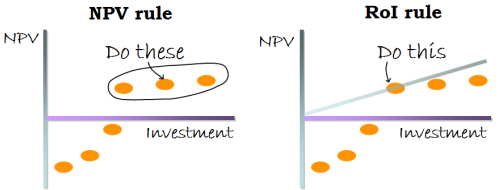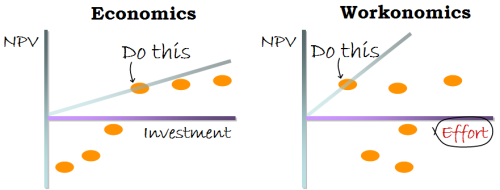If you have a bunch of projects you could do, and want to decide which ones to take up, I was taught a rule: if a project has positive net present value, do it.
That is, find out how much money you have to put in (& when), and how much you’ll get out (& when). Adjust for money today being worth more than money tomorrow. If it makes a profit, just do it.
There are 3 aspects to this calculation, of which two are usually ignored.
- Time value of money. Money today is worth more than money tomorrow. People usually don’t adjust for this — either because they don’t know they should, or because they’re not sure how much to adjust by. It’s usually OK to ignore this. The difference is not often much. Your estimations of cash flow are likely to be off by more than this adjustment anyway.
- Cash flow projection. This is tough too. People batch these together into two groups: what you put in and what you get out.
- Investment and return. This is the often used part. You put in money (over time), and you get money out (over time). Do you get more than you put in? How much more?
In other words, I’ve seen Return on Investment (RoI) used far more than Net Present Value (NPV).
In my MBA classes, I was taught that this is wrong. That you need to worry about RoI only if you’re budget-constrained. If you have enough money (and organisations can always borrow), you should do all profitable projects.
I can’t tell for sure if organisations are budget constrained or not. Departments do have budgets. But whether they stick to it or not depends on the department head’s risk aversion and political power. It often has nothing to do with projects.
But I’ve seen a bigger complaint cited more often: people don’t have time. Time is a bigger constraint than money.
This works in two ways. You don’t have staff to execute a more projects. Or you don’t have management time to pay attention to new projects.
If you’re constrained by money, it makes sense to maximise return on investment. But if you’re constrained by time, maximise return on effort.
BTW, effort is not the same as time. Outsourcing, for example, increases return on effort, but probably not return on investment. Vendors take money without taking up staff time (except a bit of management time). If you’re manpower constrained, and not money constrained, use them as much as possible. Similarly, investing in assets rather than in hiring improves return on effort.
When at BCG, there was a whole theme around this called Workonomics. Like Economics is about maximising return for money, Workonomics is about maximising return from your workforce. Powerful concept. It’s a pity I’ve never seen it applied where it’s really needed.
The most important thing is: at any point, you have only one constraint. Maximise return on that constraint. If it’s money, maximise RoI. If it’s staff, maximise productivity. If it’s customers, maximise share of wallet. And so on.


While the idea is robust in a broad sense and does subscribe to conventional wisdom, what we all forget is that there are a list of sub constraints. Does workonomics take into account human behaviour? Thats where the entire problem begins.. Where do you draw the line where the fun at work stops and disillusionment begins? As a businessman i might be encouraged to restrict my employees from unproductive activity, but this curbing of freedom has an effect on morale! We just cannot thing about real world problems on a two dimensional sheet of paper, but the effort is ofcourse almost always worth it. 🙂
I should clarify. More productivity means doing things in LESS time. I agree that most people confuse more productivity with more hours. Restricting employees from unproductive activity may or may not be a bad thing, but doing things faster is almost always better.
But I see your concern with Workonimics. Ultimately, it appears to be about squeezing more out of people. True. It’s often used that way. No argument there 🙁
Hello Anand, how are you. Hope you recognise me. I understand your post. But how far we can use this on day to day basis. Is it specific only on consulting side where we can see money behind every project or at other levels too. The other level here I mean, other professions. I am into a new assignment. Now I am into retail industry as a ‘Business Analyst’. My job primarily here is to analyse various reports that is coming out and raise strategic questions and try to improve the performance. So here, is there any way I can use ‘Return on Effect’ concept.In case If I can use, it would be very much useful to at this time. Krishna